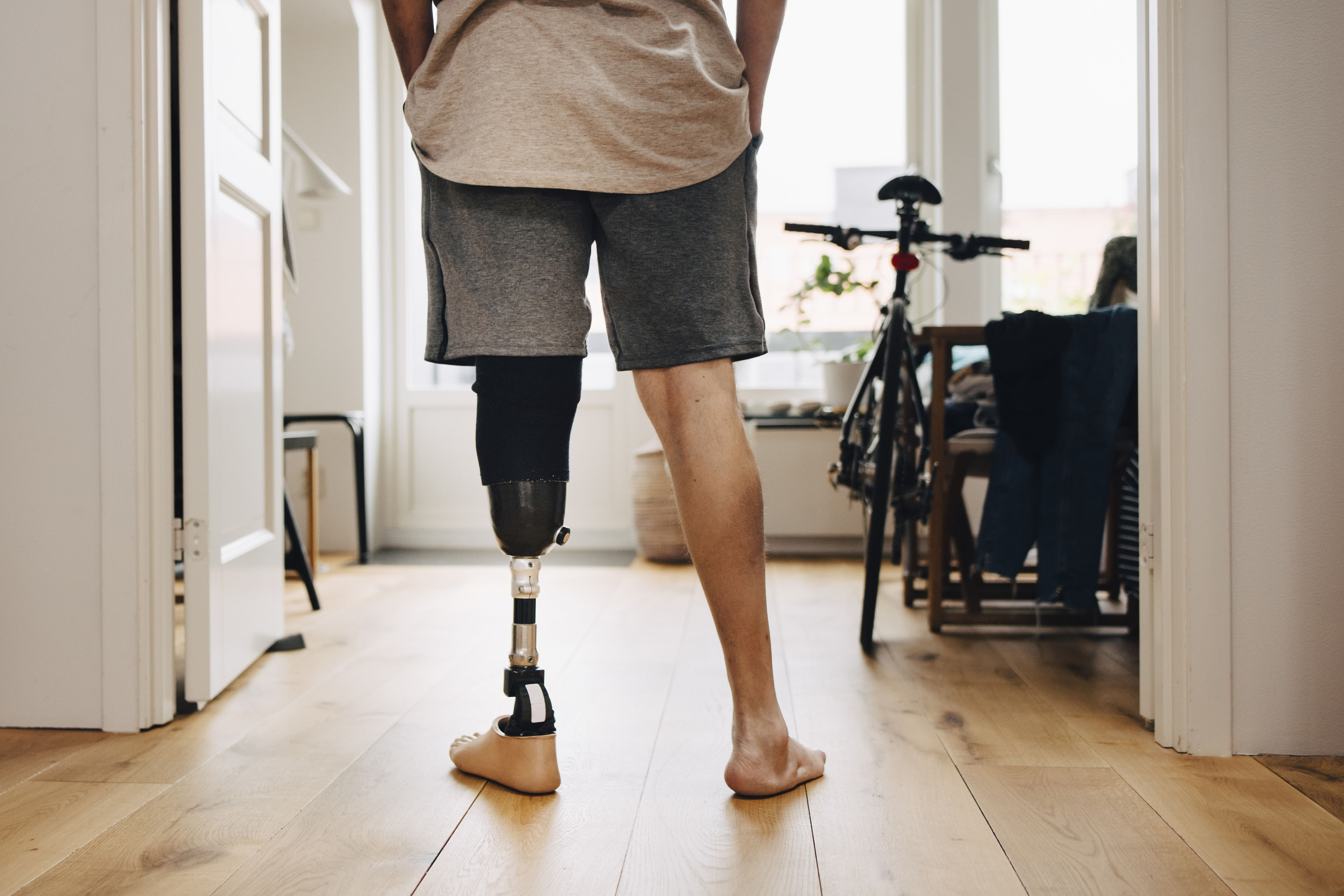After enduring years of severe gastrointestinal distress that made him want to stay home and close to a bathroom, Joseph Beinlich was diagnosed with ulcerative colitis in 2019. He was 11 years old. To ease his diarrhea, abdominal pain, and other symptoms that left him feeling wiped out, his gastroenterologist prescribed four doses a day of an anti-inflammatory drug called mesalamine. The drug helped a bit, but not enough. After taking it for two years, Joseph had a colonoscopy, which showed minimal improvement to the damage in the lining of his colon.
In January 2023, he and his parents learned about a clinical trial that was open to people ages 10 to 39, conducted at Northwell’s Feinstein Institutes for Medical Research on Long Island, N.Y., not far from their home. The trial was investigating the use of vagus nerve stimulation (VNS) for inflammatory bowel disease (IBD), an autoimmune condition that includes ulcerative colitis and Crohn’s disease. Joseph signed on and began using a non-invasive VNS device that delivers electrical stimulation to the vagus nerve through the ear, twice a day for 10 minutes at a time. The longest nerve in the human body, the vagus nerve is sometimes described as the body’s “information superhighway.” It connects the brain with all the major organs and carries vital information in both directions, in order to control functions such as heart rate, breathing, immune function, and digestion.
“Never once have I had to ask if he’s used it, because the machine makes him feel so much better,” says his mother, Danielle. Joseph went from having seven to 10 bowel movements per day to having just one or two. He became a more adventurous eater—previously, he was picky because he worried that everything would go right through him—and he gained more energy.
“It’s been a huge boost to my health—my abdominal pain went away, and I have much healthier poops,” says Joseph, now 16, a junior in high school who lives with his family in Farmingdale, N.Y. “I went from being a quiet, low-energy kid to having lots of friends, joining theater, and being more social because I have more confidence and energy.” Even after the trial ended, Joseph has continued to use the VNS device every day, along with his medication.
The Power of the Vagus Nerve
The vagus nerve is part of the parasympathetic nervous system, often called the “rest and digest” system because it helps the body relax after periods of stress and regulates bodily functions like digestion and heart rate. “The vagus nerve is the main motor nerve in the GI tract, so it controls motility, but it’s also a sensory nerve so it can affect pain,” says Dr. Thomas Abell, a professor of gastroenterology and director of GI Motility Research at the University of Louisville. “Stimulating the vagus nerve has been shown to improve immune function and quiet pro-inflammatory cytokines [signaling proteins in the immune system] in some GI conditions. Vagal stimulation has the potential to reduce pain and diarrhea [from IBD] the same way medication does.”
In other words, VNS can modulate the bidirectional communication between the brain and the gastrointestinal tract, often referred to as the “brain-gut axis.” VNS is part of a class of treatments called neuromodulation therapy: Others include sacral nerve stimulation (which is administered through the lower back) and tibial nerve stimulation (which is given through the lower leg). In a 2024 issue of the journal Medicina, a review of research on the use of electrical neuromodulation in treating IBD concluded that these techniques also show promise as therapies for IBD, especially for those who don’t get sufficient relief from medications or who experience adverse effects from them. Many people fall into this camp.
There are different ways to stimulate the vagus nerve—directly by implanting a stimulator or noninvasively with external devices that stimulate the vagus nerve via the neck or the ear, says Abell. With the surgically implanted version, a device is put into the chest to stimulate the vagus nerve with electrical impulses. With a non-invasive, handheld device, which is being investigated for treating IBD, electrical stimulation is administered through the skin to either the right or left branches of the vagus nerve in the neck or the ear.
Read More: How to Navigate Dating When You Have IBD
The handheld device is like a mobile phone with a battery pack and an earbud that’s placed in the ear. When it’s turned on, “it creates a buzzy feeling like pins and needles,” says Joseph Beinlich. “It’s not intrusive or unpleasant.” As for the effect on symptoms, he adds, “I don’t notice the effects immediately but when they kick in, the bathroom visit is much more pleasant.” He no longer experiences bloating, cramping, or urgency.
Right now, VNS is used for IBD primarily on a research or experimental basis; it hasn’t been approved by the U.S. Food and Drug Administration (FDA) to treat IBD but can be administered off-label for that purpose. The FDA has, however, approved VNS to treat refractory (drug-resistant) epilepsy, drug-resistant depression, cluster headache, migraine, and stroke recovery. Meanwhile, VNS is being investigated as a potential treatment for many other neurologic, immunologic, and additional medical conditions.
Exactly how VNS improves these various conditions isn’t completely understood, but one common denominator relates to inflammation. “There’s a rich immune system population that lives in the intestine. In people with IBD, the immune system is primed to be overactive and release chemicals that lead to injury of the intestines,” explains Dr. Benjamin Sahn, lead author of the IBD study Joseph participated in and an instructor at the Institute of Bioelectronic Medicine at the Feinstein Institutes for Medical Research. “If we can augment what signals are going through the vagus nerve [with VNS], we can activate certain pathways that turn down inflammation signals. If we can help restore an equilibrium, that would be therapeutic.”
In particular, stimulating the vagus nerve increases the release of acetylcholine (a neurotransmitter), which “interacts with immune cells and reduces inflammatory cytokines,” explains Dr. Jordan Axelrad, codirector of the Inflammatory Bowel Disease Center at NYU Langone Health and an associate professor of medicine at the NYU Grossman School of Medicine. In addition, research suggests that stimulating the vagus nerve can decrease intestinal permeability in IBD and other gastrointestinal disorders.
“When VNS is used in animals in the lab, we see a decrease in pro-inflammatory cytokines and some increase in regulatory, anti-inflammatory cytokines,” says Dr. Byron Vaughn, an associate professor of medicine and codirector of the Inflammatory Bowel Disease Program at the University of Minnesota in Minneapolis. “Translating that data to humans has been slow. Studies in people have been with small populations.”
In one study involving 22 people, ages ten to 21, with mild to moderate Crohn’s disease or ulcerative colitis, Sahn and his colleagues had the participants self-administer VNS through the outside of the left ear for five minutes, twice per day. After 16 weeks, the participants experienced a 50% reduction in their fecal calprotectin levels—a measure of inflammation in a stool sample—and 50% of those with Crohn’s disease achieved clinical remission while 33% of those with ulcerative colitis did.
Read More: Why Gut Health Issues Are More Common in Women
“With IBD, the symptoms vary from person to person,” explains Sahn, who is also codirector of the Pediatric Inflammatory Bowel Disease Center at Cohen Children’s Medical Center in Queens, N.Y. “Just about any symptom someone has—diarrhea, blood in the stool, abdominal pain, joint pain, fatigue, or headaches—can improve” with VNS.
VNS is a potential boon for treating IBD, because many people with the condition don’t respond sufficiently to medications that are used to treat it. “Our medications are getting better all the time—even so, we have only a 50% to 60% success rate,” Sahn says. “That leaves a lot of people who don’t achieve remission or who get partial responses to medications.” Indeed, a review of studies on the use of immunosuppressive drugs called anti-TNF-α agents for IBD in a 2021 issue of BMC Gastroenterology found that remission occurred in only 45% percent of people with ulcerative colitis or Crohn’s disease after one year.
People with IBD who have a partial response to medications or can’t tolerate the medications as well as those who have mild Crohn’s disease may be good candidates for using VNS. “For those with mild Crohn’s, use of immunosuppressing medications may be overkill,” says Sahn.
While Sahn believes VNS could be used on its own or with medications, other IBD experts see VNS as more of an adjunctive therapy. “This is not something that will replace medications but if your medical therapy is not doing enough, this is a reasonable thing to consider,” Vaughn says.
In terms of treating IBD, there are two goals—to relieve symptoms and to reduce inflammation and damage to the intestines. It’s not always easy to achieve both goals simultaneously. “Sometimes the best we can do [for IBD] is symptom relief,” Vaughn adds. “VNS may have a potential role for people who have symptoms that are disproportionate to their inflammation.”
Lingering Unanswered Questions
“There’s still a lot more we need to learn about the dose and the VNS settings,” Sahn says. Treatment with the non-invasive device is generally well tolerated, though VNS can cause slight skin irritation or a temporary cough or hoarseness (if it’s administered through the neck) while the stimulator is on, Vaughn says.
To find out if you’re a good candidate for using VNS for IBD, discuss the treatment approach with your care team. First, ask your doctor if they know about the use of VNS for IBD because “many gastroenterologists may not even be aware of this,” Axelrad says. If non-invasive VNS devices are available near you, ask your gastroenterologist how you can use VNS to treat your IBD and how often it should be done. It’s also important to find out what the expectations are in terms of improving your symptoms, Axelrad says.
Read More: 8 Apps That Can Help You Manage IBD
Even though VNS hasn’t yet been approved by the FDA for the treatment of IBD, “someone can use it with proper guidance from a physician who has awareness of VNS and IBD and how the two might fit together,” Sahn says. Keep in mind that while some medical centers will provide non-invasive VNS devices to patients, insurance coverage may be an issue, Vaughn says. To sidestep this challenge, ask your doctor if there’s a clinical trial you can join.
Experts agree that more research needs to be done to figure out the best targets for treating IBD and how VNS might fit into someone’s treatment protocol. Given the high rate of refractory IBD, the best way to treat these disorders may involve a “multimodality approach,” as Axelrad puts it. In addition to medications and neuromodulation, this could include dietary modifications, regular exercise, and alternative practices such as acupuncture. These days, there’s a strong focus on personalizing treatment for IBD, Sahn says. If further research supports its use for IBD, VNS may earn a welcome place in the arsenal of treatments.


![No-Bake Banana Nut Vegan Protein Bars [gluten-free + no added sugar]](https://i0.wp.com/healthyhelperkaila.com/wp-content/uploads/2020/04/BananaNutBarsFeatured-copy.png?fit=800%2C800&ssl=1)
![Healthy High-Protein Copycat Peanut Butter Chocolate Chip Crumbl Cookies [No Sugar Added]](https://i0.wp.com/healthyhelperkaila.com/wp-content/uploads/2024/07/PBCrumblCookiesFeatured.png?fit=1515%2C1515&ssl=1)















 English (US) ·
English (US) ·